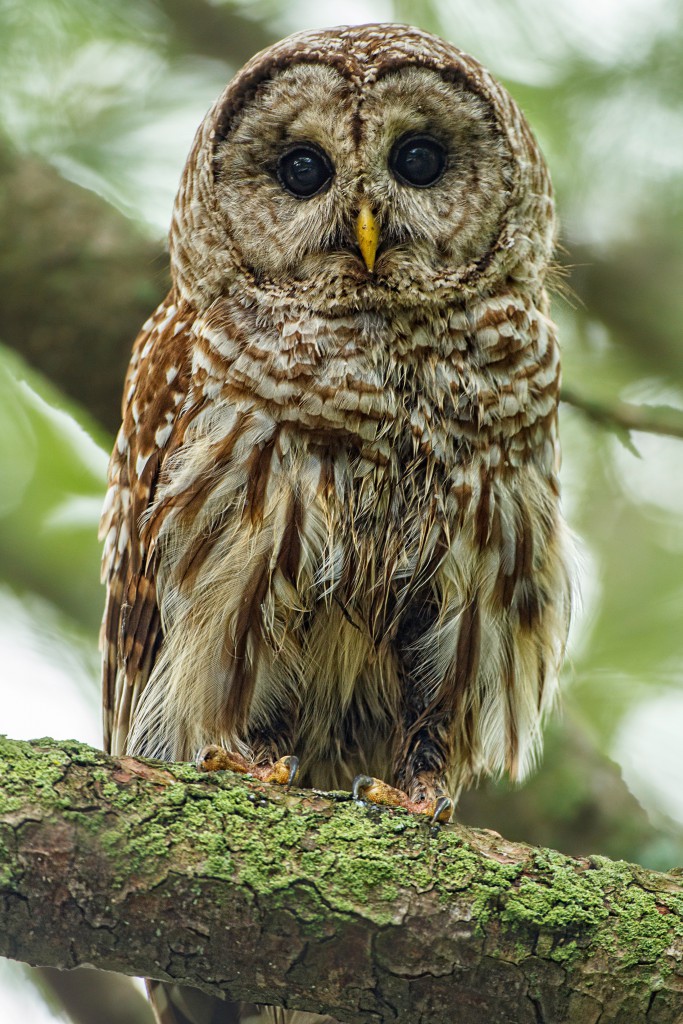Owls are incredibly fascinating creatures. With over 200 species worldwide, owls are found in most ecosystems – forests, plains, mountains, deserts, and even the tundra. Growing up, I remember seeing various birds of prey at Dauset Trails during field trips and family visits, including owls. In the 4th grade, we read Mrs. Frisby and the Rats of NIMH and dissected owl pellets as part of learning experiences. Some birds of prey, like owls, produce pellets that are regurgitated undigested parts of a bird’s diet. The pellets will include the exoskeletons of insects, bones, fur, feathers, claws, teeth, etc. As a seasonal environmental education instructor at Wahsega 4-H Center, Night Wildlife was one of my favorite classes to teach, and I always enjoyed sharing about owls with young people.
Owls are nocturnal, meaning they are active at night. Contrary to popular belief, owls can’t rotate their heads 360 degrees. However, they can turn their necks 135 degrees in either direction, giving them 270 degrees of total movement. Perhaps most fascinating to me, owls make virtually no noise when they fly. With an ordinary wing, air rushes over the wing, creating “gushing” noises because air turbulence builds up. Owls have special adaptations on their feathers that break the turbulence, making their flights nearly silent.
One of my favorite things to do during dusk hours is to go on an owl prowl. Searching for wild owls at night requires minimal supplies and can be hours of fun! First, you’ll want to learn about the common owl species in your area. The Georgia DNR and Georgia Museum of Natural History website are excellent sources to learn more about owls throughout the state. The Eastern Screech-Owl is Georgia’s most common owl. Other owls found throughout the state include the Barred Owl, the Barn Owl, and the Great Horned Owl. Considering teaching yourself how to identify owls based on their calls. The National Audubon Society provides some excellent tips for learning owl calls. My personal favorite is the Barred Owl; their call sounds like are asking the question “who cooks for you? Who cooks for you?”
Download the Audubon Owls Guide app, produced by the National Audubon Society. You may want to consider purchasing a portable, battery-powered Bluetooth speaker to bring with you on your prowl. This speaker can help amplify the sound of the calls, instead of just relying on a smart device. A flashlight can also be helpful, but be sure to add a red-light filter as direct white-light will cause damage to the owl’s eyes.
As with any other activity, there are important safety tips to keep in mind. Be sure you have permission to be on the property. Choose a wooded area or field where there are few or no light sources. Travel with a small group and be sure to let others know where you are going and when they can expect you home. Dress appropriately for the weather and check the forecast. Low-wind and clear-skies are ideal for owl prowling. You’ll want to venture out in the late dusk to evening hours. Remember, owls are nocturnal, meaning the will be most active at night.
After arriving at your location, play a few of the owl calls. The Audubon Owls Guide app provides multiple calls for the same species of owl. Always call out for the smaller owl species first (E.g. – Eastern Screech Owl) before progressing to larger species (E.g. – Great Horned Owl). Doing this is the opposite manner will lead to the smaller owls not approaching the area because they think their predators (the larger owls) are near. Whisper and walk as quickly as you can. Loud noises will deter owls from visiting.
Be patient. After playing a few calls, make sure to pause for a few minutes. Owls may call back from a substantial distance, so you will need to listen carefully. Sometimes, they will fly closer to you. Be respectful of their presence. Other times, owls may continue to stay in their location and continue to call back and forth with you. If you don’t have any success, consider playing the calls of another species. Remember, to go in order from smallest to largest. You might also consider a new location. Even under ideal conditions, you might be unsuccessful … so try again on another day. Owl prowling is truly a rewarding experience full of adventure. Happy prowling!
